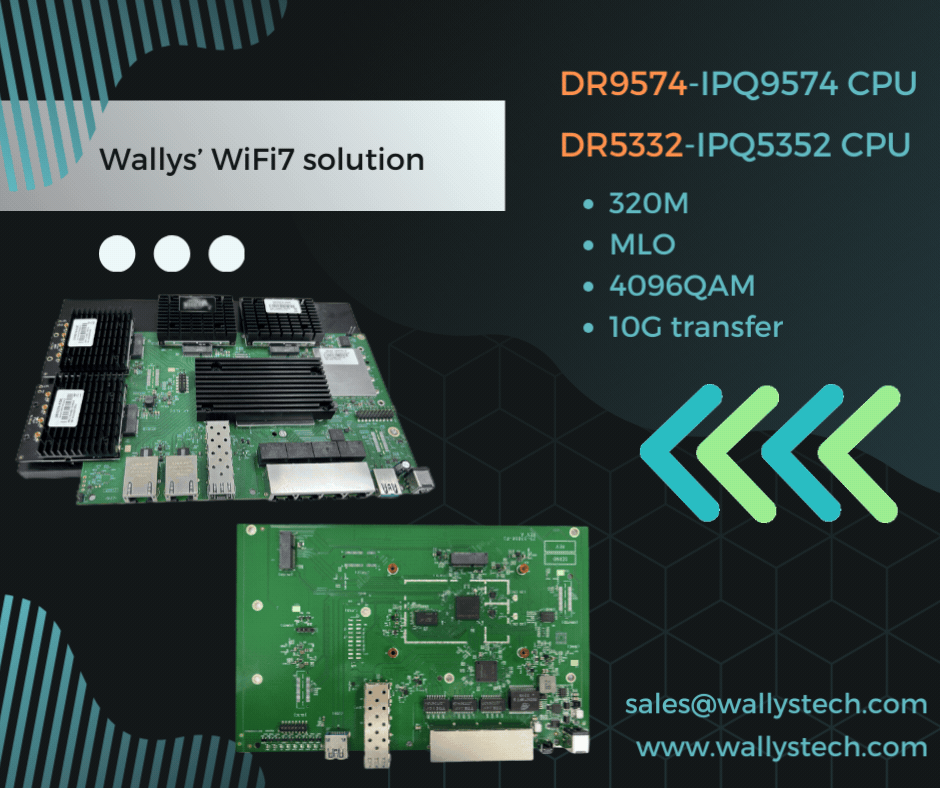電子工程網(wǎng)
標(biāo)題: IPQ9574,IPQ5332,IPQ9570-WiFi 7 chip diversity: Performance, application and market differences analysis [打印本頁(yè)]
作者: wallyswifi 時(shí)間: 2024-10-16 13:06
標(biāo)題: IPQ9574,IPQ5332,IPQ9570-WiFi 7 chip diversity: Performance, application and market differences analysis
IPQ9574,IPQ5332,IPQ9570-WiFi 7 chip diversity: Performance, application and market differences analysisDifferent chips, such as the WiFi 7 chip, are designed to meet different needs and application scenarios. Mainly from the following aspects of analysis:
### 1. ** Performance requirements **
- ** Processing power ** : Different chips have a big difference in processing power. Chips like IPQ9574 and IPQ5332 may differ in the number of CPU cores, frequency, cache size, etc., which will directly affect their performance when processing network data and performing multitasking. High-performance chips, such as the IPQ9574, are typically equipped with more powerful cpus to support more complex operations and higher concurrent processing power.
- ** Wireless speed ** : The WiFi 7 standard supports transmission speeds of up to 30Gbps, but achieving this requires the corresponding chip to support different frequency bands and modulation technologies. Different chips may support different channel bandwidths (such as 160MHz, 320MHz), which affects the maximum transmission speed of the device.

### 2. ** Target application scenario **
- ** Consumer vs Commercial ** : Chips are also designed with their main application scenarios in mind. For example, the IPQ5332 may be designed for small and medium-sized businesses to provide stability and reliability, while the IPQ9574 is aimed at the high-end router market, supporting higher throughput and more device connections. For consumer-grade products, factors such as price and power consumption will also have higher trade-offs.
- ** iot Device Support ** : Some chips will be optimized specifically for iot applications, supporting more wireless protocols and low-power modes, rather than simply pursuing high performance.
### 3. ** Connection features **
** Band support ** : WiFi 7 chips can work in different frequency bands such as 2.4GHz, 5GHz, 6GHz, and different chips also differ in terms of support frequency bands and switching capabilities. For example, some chips can operate on multiple frequency bands at the same time, providing better signal coverage and connection stability.
- ** Multi-user Scheduling (MU-MIMO) ** : WiFi 7 introduces more advanced multi-user transmission technology, and different chips have different support capabilities in this regard. High-end chips may support more spatial streams and can serve more devices simultaneously, improving overall network efficiency.
### 4. ** Power Management **
- ** Low power design ** : Power consumption is a very important part of chip design, especially for embedded devices and applications that require long running times. Different chips have different optimization strategies for power management. For example, the IPQ5332 may be more focused on energy efficiency, while the IPQ9570 is more focused on power balance in high-performance scenarios.
- ** Energy-saving protocol support ** : WiFi 7 has many improvements in energy saving, supporting functions such as TWT (Target Wake Time), and the implementation degree and optimization effect of different chips on these protocols will also be different.
### 5. ** Security **
- ** Built-in security module ** : High-end chips may have built-in more advanced security modules that support hardware-level encryption, authentication, DDoS protection and other functions to ensure the security of data transmission. These features are especially important in enterprise-class applications, as they provide greater privacy protection and protection.
- ** Firmware Update support ** : Some chips are specifically designed to facilitate online firmware updates to respond to new security threats. In the face of network attacks, it can quickly respond to improve device security.
### 6. ** Market and cost considerations **
- ** Chip cost ** : The design and manufacturing costs of different chips are also very different, which will directly affect the price of the end product. Chips with higher performance and more functions are usually more expensive to manufacture, so these chips will be used in higher-end devices, while chips in the middle and low-end market will compromise on performance and features to achieve cost control.
- ** Supply chain stability ** : When different manufacturers choose chips, they will also consider the stability of the supply chain. Some chip designs may need to rely on specific manufacturing processes or supply chain partners, which is also a big factor in choosing different chips.
### Summary
Different WiFi 7 chips differ in terms of performance, application scenarios, connection characteristics, power consumption, security, and cost. These differences allow them to better meet the needs of a diverse market, whether it is home, enterprise routers, or iot devices. Chip manufacturers cover a wider range of markets through diversified product lines, ensuring that the right solution can be found for every application scenario.
| 歡迎光臨 電子工程網(wǎng) (http://www.qingdxww.cn/) |
Powered by Discuz! X3.4 |
主站蜘蛛池模板:
亚洲图片在线
|
麻豆日韩国产精品欧美在线
|
国产一卡二卡3卡4卡更新
|
成人中文字幕在线
|
四虎一影院区永久精品
|
欧美一区精品二区三区
|
欧美精品v国产精品v
|
春意影院午夜免费入口
|
四虎4hu永久免费国产精品
|
精品欧美小视频在线观看
|
国产三级小视频在线观看
|
日本免费网站
|
日日插天天干
|
我不卡视频
|
国产一级一片免费播放刺激
|
中文字幕二区三区
|
欧美啄木乌成人系列影片bt种子
|
老潮湿影院免费体验区
|
2019国产精品青青草原
|
污污的免费网站
|
www毛片|
午夜欧美成人香蕉剧场
|
99久久免费国产精精品
|
性夜影院爽黄a爽免费视
|
免费高清小黄站在线观看
|
综合五月天
|
久久夜色视频
|
久草国产视频
|
国产一级片免费观看
|
免费看91视频
|
www.亚洲免费
|
色多多幸福宝
|
久久国产精品一国产精品金尊
|
亚洲国产天堂在线观看
|
亚洲日本在线观看
|
亚洲精品不卡久久久久久
|
日本在线观看中文字幕
|
国产91精品对白露脸全集观看
|
亚洲国产精品免费在线观看
|
99国产精品免费观看视频
|
欧美专区视频
|
